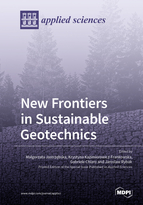New Frontiers in Sustainable Geotechnics
A special issue of Applied Sciences (ISSN 2076-3417). This special issue belongs to the section "Earth Sciences".
Deadline for manuscript submissions: closed (30 April 2022) | Viewed by 43766
Special Issue Editors
Interests: geotechnics; advanced laboratory and field testing; sustainable geotechnical environmental engineering; weak soils; soil improvement
Special Issues, Collections and Topics in MDPI journals
Interests: geotechnics; environmental engineering and civil engineering materials and others
Special Issues, Collections and Topics in MDPI journals
Interests: earthquake geotechnical engineering and related problems; geo-disaster risk assessment and mitigation; development of advanced laboratory and field-testing devices; sustainable geotechnical engineering; ground improvement techniques; computational geotechnics
Special Issues, Collections and Topics in MDPI journals
Interests: geotechnical engineering; civil engineering; piles foundation; deep excavations; soil improvement technologies; reuse of waste material; sustainable geotechnics
Special Issues, Collections and Topics in MDPI journals
Special Issue Information
Dear Colleagues,
With increasing ecological awareness, the idea of balanced development has become commonly used. Meeting the socio-economic needs of humans in the context of maintaining the ecological balance is incredibly important. Geotechnical engineers are also faced with this difficult task. Currently, their work is focused on three wide areas: sustainable ground improvement, sustainable foundation engineering and sustainable geotechnical design.
Please share with other researchers your experiences in the fields of (1) the use of alternate, environmentally friendly materials in geotechnical constructions like embankments, slopes, dams, and reuse of waste materials like rubber waste, fly ash, natural or artificial fibers for soils improvement and stabilisation, (2) innovative and energy efficient ground improvement techniques, (3) bio-slope engineering, (4) efficient use of geosysnthetics, (5) retrofitting and reuse of foundations, and foundations for energy extraction (e.g. termopile), (6) use of underground space for storage of energy, (7) mining of shallow and deep geothermal energy, (8) making geo-structures reliable and resilient in the case of natural or man-made hazards, (9) design and modeling on the basis of geotechnical parameters derived, (10) experiences with solving geotechnical challenges in marine engineering (such as predicting seabed liquefaction, designing marine foundations and anchors).
Prof. Dr. Małgorzata Jastrzębska
Prof. Dr. Krystyna Kazimierowicz-Frankowska
Prof. Dr. Gabriele Chiaro
Dr. Jaroslaw Rybak
Guest Editors
Manuscript Submission Information
Manuscripts should be submitted online at www.mdpi.com by registering and logging in to this website. Once you are registered, click here to go to the submission form. Manuscripts can be submitted until the deadline. All submissions that pass pre-check are peer-reviewed. Accepted papers will be published continuously in the journal (as soon as accepted) and will be listed together on the special issue website. Research articles, review articles as well as short communications are invited. For planned papers, a title and short abstract (about 100 words) can be sent to the Editorial Office for announcement on this website.
Submitted manuscripts should not have been published previously, nor be under consideration for publication elsewhere (except conference proceedings papers). All manuscripts are thoroughly refereed through a single-blind peer-review process. A guide for authors and other relevant information for submission of manuscripts is available on the Instructions for Authors page. Applied Sciences is an international peer-reviewed open access semimonthly journal published by MDPI.
Please visit the Instructions for Authors page before submitting a manuscript. The Article Processing Charge (APC) for publication in this open access journal is 2400 CHF (Swiss Francs). Submitted papers should be well formatted and use good English. Authors may use MDPI's English editing service prior to publication or during author revisions.
Keywords
- sustainable ground improvement
- sustainable foundation engineering
- sustainable geotechnical design
- waste materials
- soils improvement and stabilization
- geothermal energy and foundations
- reliability and resilience of geo-structures
- reliability-based design









